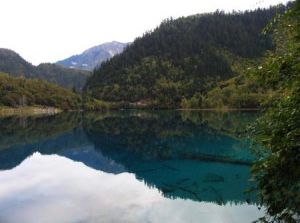Jiuzhaigou
Jiuzhaigou in Jiuzhaigou County is a 50-km-long deep valley in the Minshan Mountains. Literally translated as the Nine Village Valley, it is named after nine Tibetan villages that are located there. It was also known as Goats' Cave and Green Sea in ancient times. The valley is between 2,000 and 3,100 m above sea level and is composed of the three gullies, totaling 720 sq. km in length.
Green waters, cascading waterfalls, snow-capped peaks, colorful forests, and Tibetan folklore are the "Five Supremacies" of the valley scenery, enhanced by its unique geological and primeval features. The valley is flanked by dozens of snow-capped peaks rising up into the clouds. Primeval forests slope down the mountainsides into the valley. They are home to more than 2,500 species of protophytes, including such living fossils as the Kingdonia uniflora Balf, Circaeaster agrestis Maxim, and arrow bamboo (Sinarundinaria nitida) from the late Cretaceous and early Tertiary periods, and 311 rare species of wildlife, including three species listed under state protection, such as the giant panda, golden-haired monkey, and antelope.
The beauty of Jiuzhaigou is best represented by its kaleidoscopic water scenery. It has more than a hundred bodies of water, small ones being no more than a few square meters in size and large ones extending as long as seven kilometers, which the local Tibetans address indiscriminately as "seas." Different colors of pebbles at the bottom of these lakes and water plants work with refractions of golden sunlight to give the lakes a wonderful diversity of colors. The Y-shaped three gullies form a matchless landscape.
A 7.0-magnitude earthquake jolted Jiuzhaigou County at 9:19 p.m. August 8, 20017 and the epicenter was monitored at 33.2 degrees north latitude and 103.82 degrees east longitude. The quake struck at a depth of 20 km, according to the China Earthquake Networks Center (CENC).
